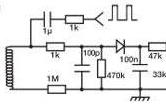An LED lighting driver chip with in-built 0-10V dimming designed by iWatt does not require a microprocessor to control the dimming function.

"We believe this is the first product from anyone with 0-10V dimming without a separate microprocessor," Hubie Notohamiprodjo, iWatt director of marketing for lighting products, told Electronics Weekly.
Called iW3630, the chip is intended for commercial lighting with loads up to 45W.
As it is aimed at professional use, it is a two stage design to allow power factor correction without 100/120Hz flicker at the LED.
"It maintains a high power factor (PF) even at loads down to 20% of full load, and offers a low total harmonic distortion of under 15% to meet global regulations," said the firm.

Temperature sensing is included to prevent over-hot LEDs spoiling product lifetime - particularly a problem, even with well-designed luminaires, where they are installed in small spaces.
Dimming, in this case, comes from the RF module. The interface is either PWM or analogue voltage. See below for 0-10V diming.
"When thermal conditions reach a point set by the system designer, the driver automatically reduces the current drive to the LEDs, lowering the power dissipation for cooler operation," said iWatt. "This avoids the risk of thermal runaway, ensures the temperature rating of the electrolytic capacitors in the lighting system is not exceeded, and allows a predictable operating life."
0-10V (and 1-10V) dimming signals are handled by a novel circuit (see below) and can produce a 1% to 100% variation in output current.
Current regulation is to +/-5%, using primary-side sensing which needs no opto-isolator.
If wireless dimming is required, a separate receiver and decoding microcontroller must be added.

To interface with such a microcontroller, the 3630 is also capable of 1-100% dimming when commanded by a PWM waveform, and by an analogue voltage direct to the chip.
As well as temperature protection, "additional built-in protection features include LED open and short detection, input over-voltage, over-current, and current-sense resistor short", said the firm, claiming: "This combination of on-board functions results in a typical bill-of-materials less than 70 components."
The on-chip controller is digital and can adapt to different input voltages, output currents, and numbers of LEDs, said the firm, claiming that this flexibility can allow a single ballast using the chip to be used in multiple luminaire designs.
iW3630 iWatt isolated off-line ac/dc controller
Power factor >0.95
THD < 15%
Output up to 45W
45-66Hz line frequency
Analogue and PWM dimming
1% to 100% dimming range
Isolated 0-10V dimming
Quasi-resonant operation
Works from dc emergency voltage
Protection:
over-temperature LED de-rating
output over-voltage, over-current and short circuit
open LED sense-resistor short circuit
That cunning isolation technique
The iW3630 from iWatt is compatible with 0-10V, and 1-10V dimming.
To isolate the control voltage from the mains for safety, the company has taken the unusual step of using a transformer on a dc circuit.
Some components are needed on both sides of the transformer, and to make the circuit work the TDRV pin of the chip provides a 30% duty-cycle square wave of around 12V amplitude.
If there was no drive waveform (see circuit), nothing would pass across the transformer. With no bias, the transistor would turn off and there would be no load on the 0-10V dimming controller.
Imposing the TDRV waveform on the chip side of the transformer causes a waveform to appear on the control side, which is clipped by the shunting action of the transistor when in reaches the dimmer voltage + a diode drop + the transistor Vbe.
This clipping changes the impedance on the control side of the transformer, effectively clipping the possible excursion on the chip-side to the same voltage.
A diode peak detector on the chip side stores this clipped peak value on the 1nF capacitor for use as a dimming voltage.
With this simple circuit, there is an error of one Vbe in the voltage detected on the chip side compared with 0-10V control voltage.
"There is a diode drop error. This is within the error window of the 0-10V control specification," Hubie Notohamiprodjo, iWatt director of marketing for lighting products, told Electronics Weekly.
The 0-10V specification is treated fairly casually by the lighting industry, and some organisations officially use 1-10V.
"Some companies prefer an offset, and move from 10V to 9V for 100% brightness, and get current down to minimum at 2V," said Notohamiprodjo. "There is more circuitry to add if 2-9V dimming is preferred."
The control pin on the chip (DIM) provides 100% brightness at 1.8V, decreasing linearly to 1% at 0.2V.
0-10V control voltage sources are required to be able to both source and sink a certain amount of current.
The iWatt interface circuit uses the controller sinking capability as it pushes current out towards the 0-10V voltage source, although most of this is shunted by the transistor.
1mA, limited by the 1kΩ input resistor, is the most that can flow back into the controller. According to Notohamiprodjo, 1mA nominal (2mA max) is the most that ballasts are allowed to source to, or sink from, the 0-10V control bus.
"The whole circuit has very limited drive current by design," he said. "In a system of 100 drivers, the 0-10V controller needs to be able to sink 100mA."
If no controller is connected, and the input left open circuit, the input drifts up to 10-11V and the LED current goes to maximum - which can be dimmed by an appropriate variable resistor connected across the input.





